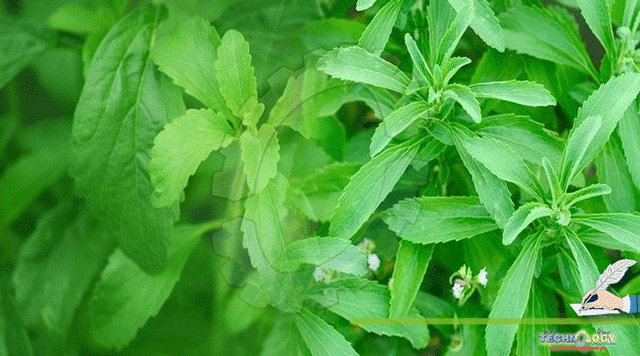Stevia rebaudiana is a perennial herb that is belongs to the Asteraceae family. It is non-caloric plant and sweet plant it have medicinal and commercial importance value.

By Safina Rani, Athar Mahmood, Maria Naqve
Due to sweetness it is 300 time sweater than can sugar and used in all countries. It is “Madhu patra” in Sanskrit language that means sweet leaf. It’s also called honey yerba plant.
Medicinal uses of stevia:
In Paraguay, Japan and Brazil It is used as herbal medicine. It is used in many products in Japan. The Japanese people used stevia in soft drinks, seafood and candies etc. Stevia is also used in heart burn disease and other ailments. Sweet leaf sweet weed and sweet herb is the nick name of stevia. From 200 species of stevia only S. rebaudiana give sweet flavor. It grows at the Amambay mountain range of Paraguay. The leaves of stevia herb contain substance (glycosides), which produce a sweet taste but have no caloric value. It is apart from protein, fibers, carbohydrates, phosphorus, iron, calcium, potassium. It produce purified glycosides because it consist of shadow dehydrated leaves. Diterpene glycosides are the group of ordinary sweeteners that have been take out from Stevia. Steviol glycosides are also harmless for phenylketonuria patients as no aromatic amino acids are elaborate. Stevioside varies from rebaudioside A by having one less glucose moiety.
It is short day plant. In Paraguay its temperature ranges from 6 to 43 C at latitudes. This plant is therapeutically important due to its hypolipidaemic, hypoglycemic anti-inflammatory, anti-hypertensive and anti-proliferative effects in tumor cells. The plant also shows antioxidant. It is sensitive to low temperature in the sprout stage. In the climate and soil it is grown under the diverse condition. Due to higher salinity the level of growth and yield become less. The plant extract from stevia plant and play very major role in food and beverages. The stevia extracts have economic and scientific interest and have nutritional benefits. The phytochemical constituents of stevia is amino acid, vitamins, minerals and polyphenols. The reinforcement of diary food with herbal extracts have antioxidant and antimicrobial activities. It play very important role in preservation. In obesity person, it also has been used to help control weight. It also play role in hypertension and diabetes.
Application of stevia plant:
It stop the weakness, sadness against fungal diseases. Furthermore, the concentration of stevia leaf have been using for cancer prevention agent and antimicrobial movement. The characteristics of stevia are similar to sucrose but has no effect on blood sugar. In cancer prevention agent and antimicrobial activity the leaf concentrate of stevia has been accounted for elevated sensation. The ideal planting density is 85,000 to 110,000 plants per hectare. The dry leaf yield varies from 2000 to 3000 kg/ha and Stevioside content ranges from 15- 20% of dry weight. The leaves of stevia are rich in tennis and other phytonutrients. Now in India, Pakistan, China Bangla, Bhutan, Sri Lanka and Malaysia stevia are commercially cultivated. In the coming years, there will be high demand in the used of medicinal plant. In the developing countries, due to their greater safety it compared to synthetic drugs. It is safe for all ages of people according to the researcher and scientists. In daily routine we can use stevia extract 5 to 6 mg in body weight.
In comparison to the artificial sweeteners Stevia possess several advantageous properties that include;
1. Appetite regulation / suppression.
2. Being zero calorie sweeteners, assists in weight management / weight loss (as it reduces
craving for sweets).
3. No major safety concerns.
4. Ideal for cooking and baking as it is no fermentable and heat stable up to 200°C
5. Calorie value is 2.7kcal/gm.
6. Intense in its sweetening property.
7. Cheaper as compared to other sweeteners.
8. Safe and beneficial in management of diabetes and obesity.
Uses and application in food industry.
From the above-mentioned considerations, it is clear that the addition of stevia glycosides can increase the palatability. It also increase the enjoyment of food by improving flavors and smells. Growing number of Stevia-based products on the world market, such as drinks, table-top sweeteners. Candy and other processed foods, personal hygiene products and various Japanese delicacies. Specifically, Stevia extracts have been used to sweeten low-calorie soft drinks, soy sauce, and dried seafood. Candy, ice cream, chewing gum and yogurt in several countries, but principally Japan, Korea and Brazil. Information about the proportions of these sweeteners used in each type of product is available from the literature. There have been several investigations undertaken aimed at evaluating the potential of Stevia as sweetener of specific products.
For example, prepared Strawberry-flavored yogurt sweetened with sucrose. Stevia or equal proportions of sucrose are last pure extract with 90% stevioside content, at three different concentration. According to the results given by the sensory panel judges, the authors determined that 6 g of Stevia is equivalent to 1000 g of sucrose. The yogurt sweetened with 4.5 g⋅ 100 g–1 of equal parts of sucrose and Stevia obtained the highest sensory acceptance scores. The apparent viscosity of the finished products was not affected by the addition of Stevia. Furthermore, after 7 days of cold storage, the degree of sweetness of all the different formulations tested remained the same. Fresh samples (made the day before) of products prepared with sucrose.